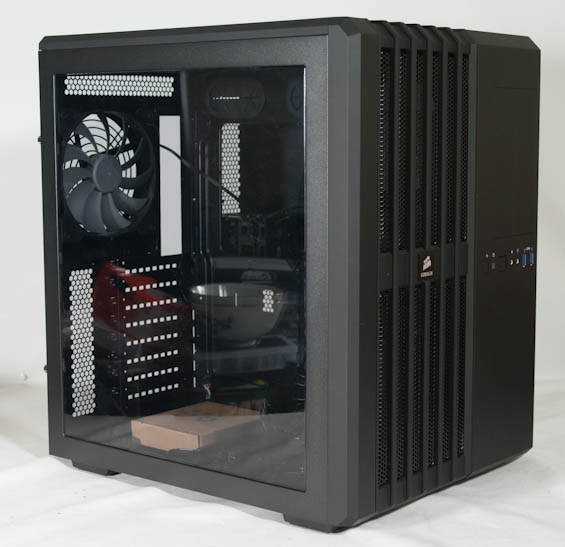The Neophyte's Custom Liquid Cooling Guide: How To, Why To, What To Expect
by Dustin Sklavos on September 30, 2013 12:01 AM ESTPlextor M5P Xtreme 256GB SSD

For this build we needed a fast SSD with enough capacity to hold our entire benchmarking suite, and Plextor was able to accommodate us. The M5P Xtreme we were sent is a 256GB SATA 6Gbps solid state drive with a 7mm height (as is becoming the norm), rated for sequential speeds of up to 540MB/sec reads and 460MB/sec writes, and a random read/write rating of 100,000/86,000 IOPS. It employs an enterprise class Monet 88SS9187 controller, and definitely met our needs during testing.
Our thanks to Plextor for this solid state drive.
Corsair AX1200i Power Supply

Truth be told, Corsair had provided me this power supply some time ago for testing with their Corsair Link software, and it's proven to be absolutely worthy for this build. The AX1200i is a fully modular, 200mm power supply rated for up to 1200 watts and 80 Plus Platinum certified, and it boasts one single, beefy 12V rail. When this unit is running at 30% or less load, the fan actually stops completely, but even under duress I found its fan noise to be negligible at worst. What makes it ideal, of course, is that it can easily supply the required current for two GTX 780s and an i7-4770K with plenty of overclocking headroom. The Corsair Link support is an added perk.
Our thanks to Corsair for this power supply.
Corsair Carbide Air 540 Enclosure

When it came to choosing a case, I really had my pick of the litter. You can plead favoritism, but honestly I've found Corsair's mid-to-high end offerings to be the most desirable for watercooling. Initially I'd planned on using the Micro-ATX Obsidian 350D, but then the Carbide Air 540 launched and I elected to go full ATX. In addition to just being a very interesting looking case, the Carbide Air 540 is perfect because it lets me test an air cooled system for comparison without having to use a case with middling air cooling performance. The case also supports a 360mm radiator in the front and a 240mm radiator in the top, giving a very healthy amount of cooling capacity when the switch to watercooling is made.
That, and like I said, it's just really neat.
Our thanks to Corsair for this enclosure.
Noctua NH-U14S Air Cooler

In order to prove the hypothesis we're entering into this review with, we need a control. Noctua's NH-U14S air cooler serves as that control; this cooler is incredibly quiet but also very efficient. This and its smaller sibling, the NH-U12S, are two of my favorite air coolers. Though they don't come cheap, they're awfully close to as good as you'll get on air if noise matters to you. The NH-U14S did not disappoint.
Our thanks to Noctua for this cooler.


_thumb.jpg)
_thumb.jpg)
_thumb.jpg)
_thumb.jpg)
_thumb.jpg)
_thumb.jpg)








106 Comments
View All Comments
bojaka - Monday, September 30, 2013 - link
And right about THERE I lost my interest in water cooling - Thanks :) I actually believed water cooling would be a viable solution to make my computer silent, but apparently not. Thanks for a great article!!utnorris - Monday, September 30, 2013 - link
You can make a near dead silent water cooled system that allows you to overclock. Unfortunately, the fans you are using in the article, while good, are not the best, regardless what marketing says. I have built probably 40 to 50 systems over the last 5 years using water cooling and noise was never an issue. If you are not overclocking then a full blown water cooling setup is not worth it, but for the added performance, it's well worth it. Also, there is no need for additives like the Hydrx, distilled water with a silver coil or some anti algae drops from your local pet store is all you need and would be less toxic. Last, as already mentioned, delidding would have seen about 10c drop on the processor and if you are going to water cool, you might as well delid your chip.Aikouka - Monday, September 30, 2013 - link
You REALLY shouldn't take a SINGLE article on water cooling as the end all, be all on whether water cooling can provide a silent build. Dustin was NOT pushing for a silent build, but rather just a build with whatever parts he was provided. I have a custom loop with an i7-4770k and two GTX 680s, and it isn't noisy at all. It is going to be a bit noisier at idle because of having significantly more fans (I have 7 120mm fans just on the radiators), but it doesn't get any noisier at load! I also use a fan controller that lets me set the fans to the speed -- and consequently, the noise level -- that I find acceptable.piroroadkill - Monday, September 30, 2013 - link
Yeah, some people think this, but since you're shifting water at the same time as pushing air, there are simply more moving parts involved. Just get a giant tower heatsink and run those fans sloooowly, and choose a GPU with a really good factory heatsink.tim851 - Monday, September 30, 2013 - link
Depends. There are much better, i.e. quieter, pumps available. The best one imo is the Aquastream by AquaComputer. Even then, a single Cpu-single Gpu system is quieter on air. A Thermalright HR-02 and an Accelero Xtreme will take care of it. Once you go SLI, however, you're running into space and heat evacuation problems. Watercooling is your only chance of acceptable noise at load now.piroroadkill - Monday, September 30, 2013 - link
Yeah, multi-GPU rigs are a different beast. At that point a custom water loop is probably your best bet.But for single CPU/single GPU rigs, water is basically a vanity project, not one that will actually give you lower noise.
piklar - Monday, September 30, 2013 - link
Great article Dustin! It just so happens I have been considering a watercooling project this summer (new Zealand time) using the Corsair Air540 with 4770K and SLI GTX 780s. Ironicly it appears The Raven RV03 is doing just as good if not better job of the cooling with Corsair H80 and reference card cooling. You have shown how luck of the draw Haswell can be since the 4770Ks Ive come across all do 4.6ghz on 2.8- 3.0v no probs. Still your article was very useful and much appreciated.Death666Angel - Monday, September 30, 2013 - link
2.8V to 3.0V? That's not right. :PRazorbak86 - Monday, September 30, 2013 - link
LOL. My thought exactly. I'm sure he meant 1.28-1.30V. ;-Ppiklar - Monday, September 30, 2013 - link
soz was half asleep, thanks for clarifying that I meant meant 1.280 - 1.30V for 4.6ghz with 4770K with H80.